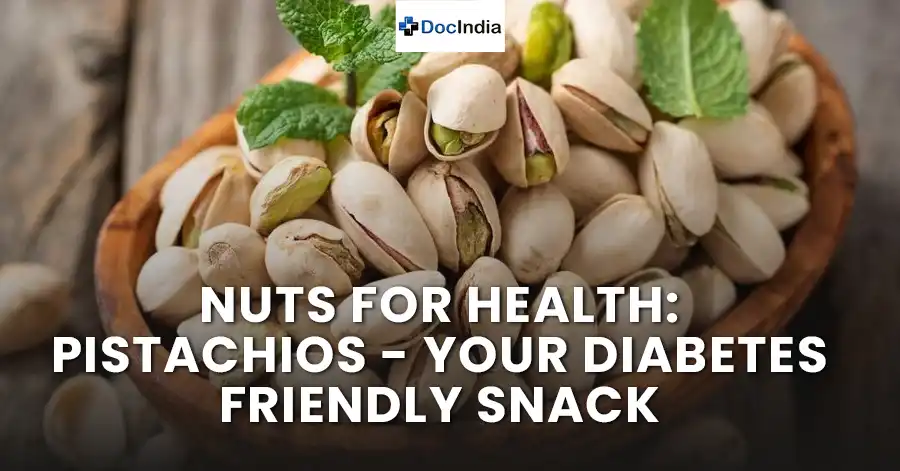Nuts for Health: Pistachios - Your Diabetes-Friendly Snack

Pistachios for Diabetes: 7 Benefits to Keep Blood Sugar Levels in Check
Diabetes care requires a careful balancing act that goes beyond prescription drugs. Blood sugar regulation is greatly influenced by nutrition, and pistachios seem to be an unexpected hero in this regard. Not only are these vivid green nuts delicious, but they also have several health advantages, particularly for those who have diabetes. Let's examine the amazing benefits of pistachios in a diabetic diet.
1. Low Glycemic Index
Pistachios boast a low glycemic index, indicating that they cause a gradual increase in blood sugar levels. This slow release of sugars into the bloodstream is pivotal for diabetic individuals, as it helps avoid sudden spikes in glucose levels, promoting better blood sugar control and insulin sensitivity.
2. Rich in Fiber
Fiber is a cornerstone of diabetes management, and pistachios shine in this department. Packed with both soluble and insoluble fiber, they aid in regulating blood sugar levels by slowing down digestion and the absorption of sugars. Additionally, their high fiber content contributes to satiety, potentially curbing overeating and aiding in weight management.
3. Healthy Fats
Despite their calorie density, pistachios are rich in heart-healthy monounsaturated and polyunsaturated fats. These fats have been associated with improved insulin sensitivity, crucial for managing diabetes effectively. Their inclusion in the diet can provide the benefits of fats without the detrimental effects of saturated fats.
4. High Protein Content
Protein plays a vital role in stabilizing blood sugar levels and managing hunger. Pistachios offer a substantial amount of plant-based protein, aiding in glucose control between meals and supporting a balanced diet for individuals with diabetes.
5. Packed with Antioxidants
The abundance of antioxidants like lutein, zeaxanthin, and gamma-tocopherol in pistachios makes them a powerful ally against oxidative stress and inflammation. These antioxidants safeguard against cell damage caused by free radicals, potentially reducing the risk of diabetic complications.
6. Magnesium
Magnesium, found in ample quantities in pistachios, plays a crucial role in glucose metabolism and insulin action. Adequate magnesium intake has been associated with improved insulin sensitivity, making pistachios an excellent addition to a diabetic diet.
7. Micronutrients
Apart from the major nutrients, pistachios contain essential vitamins and minerals such as vitamin B6, potassium, and phosphorus. These micronutrients contribute to overall health and support various metabolic functions, indirectly aiding in diabetes management.
How Many Pistachios Can a Diabetic Eat?
Finding the right amount of pistachios to eat is essential for diabetics to keep their blood sugar levels steady. Generally speaking, a normal serving size is recommended to be approximately 1 ounce, or 49 pistachios. Individual reactions, however, could differ greatly. Measuring blood glucose levels after pistachio consumption aids in determining the optimal amount for each individual. Pistachios' effect on blood sugar is dependent on a number of factors, including physical activity, nutrition, and insulin sensitivity. For some people, it may be possible to eat a little bit more or less without experiencing any negative impacts on their blood sugar levels. Therefore, it's critical to customise the portion size based on each person's tolerance and pay attention to how the body reacts. This personalized approach ensures that the intake of these nutrient-packed nuts aligns with an individual's specific needs in managing diabetes effectively and safely.
How to Consume Pistachios?
Including pistachios in your diet on a regular basis is a tasty and adaptable option. Savour them raw, roasted, or even combined into a variety of recipes. To add a delicious crunch and extra nutritional value to salads or yoghurt, sprinkle these nutrient-rich nuts on top. Blend them into smoothies to add a savoury, nutrient-rich boost that will up the health factor of your beverage. But when choosing pistachios, choose unsalted ones to reduce too much sodium consumption, particularly if you are also controlling diabetes and hypertension. This prudent decision lowers the possible risk connected to high salt levels, improving health results. Try using pistachios in savoury and sweet recipes, such as baked goods and savoury dinners, to find tasty new ways to include these heart-healthy nuts in your diet. The versatility of pistachios not only adds a delightful taste but also contributes valuable nutrients, making them a delightful and healthful addition to a diabetic-friendly diet.
Pistachios provide many advantages for people with diabetes, such as a low glycemic index, high fibre content, good fats, and an abundance of vital nutrients. They can be a useful supplement to a well-balanced diabetic diet when eaten in moderation. To create dietary recommendations that are specifically tailored for the best blood sugar control, it is imperative to take into account individual responses and speak with medical professionals.
To sum up, adding pistachios to a diabetic care plan is a tasty and nourishing strategy to control blood sugar, promote general health, and improve wellbeing.
